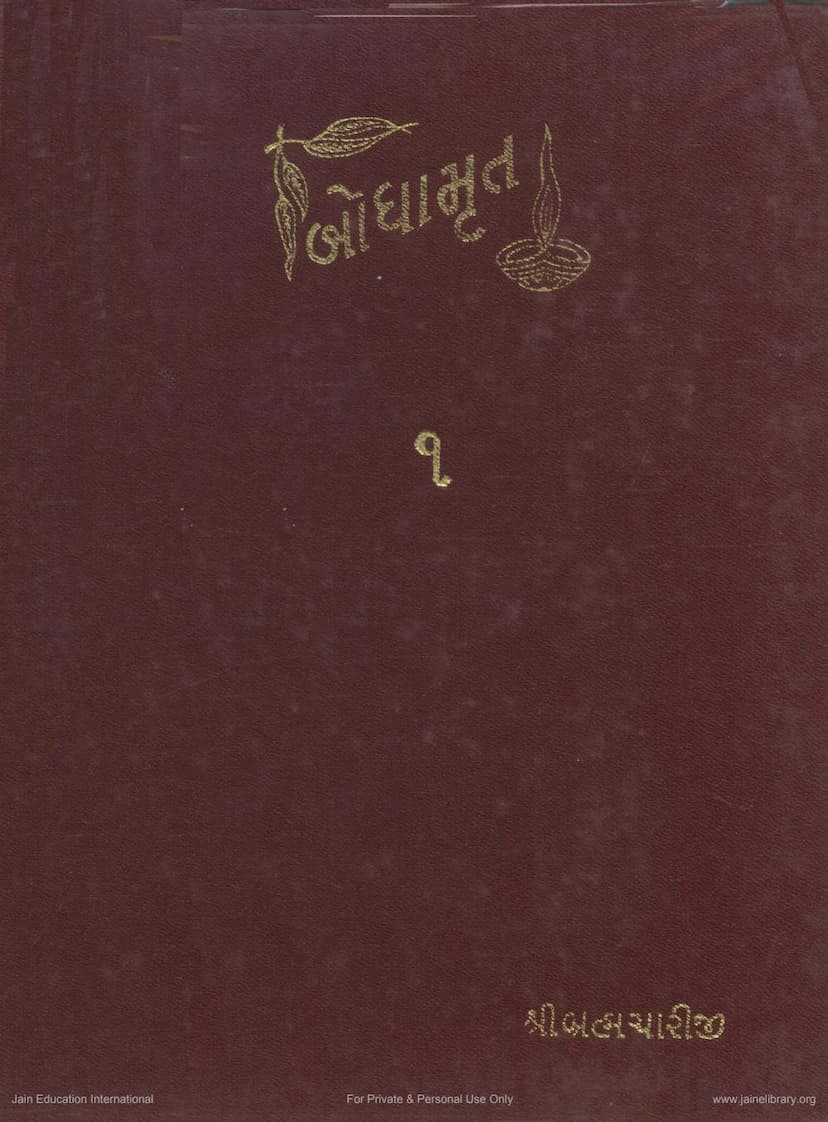Bodhamrut Part 1
Added to library: September 1, 2025

Summary
This is a comprehensive summary of "Bodhamrut Part 1" by Govardhandas, published by Shrimad Rajchandra Ashram, based on the provided text:
Bodhamrut Part 1: A Summary of Spiritual Discourse
"Bodhamrut Part 1" is a compilation of spiritual discourses and teachings delivered by Pujya Shri Brahmachariji, compiled and published by Shrimad Rajchandra Ashram. This volume, a flower of the eight-part Shrimad Laghuraj Smarak Granthamala, offers profound insights into Jain philosophy and practice. The book is a treasure trove of guidance for those seeking spiritual upliftment and liberation, drawing heavily from the teachings of Shrimad Rajchandra.
The text is structured into several collections, each containing various spiritual talks and reflections. These discourses cover a wide array of topics essential for spiritual growth, including:
- The Nature of the Self and Reality: The text emphasizes the distinction between the soul (Atma) and the body (deha), stressing that the soul is eternal, unchanging, and the true source of happiness, while the body is transient and material. It encourages introspection to realize this fundamental truth.
- The Importance of the Guru and Divine Guidance: The teachings consistently highlight the indispensable role of a Sadguru or Gyani Purush (enlightened being) in guiding the soul towards liberation. Their words and examples are presented as the direct path to understanding the self and overcoming spiritual obstacles.
- Cultivating Virtues and Renouncing Vices: The book extensively discusses the importance of cultivating virtues like compassion, patience, humility, and non-attachment. It also warns against vices such as greed, anger, pride, and indulgence in sensual pleasures, which are seen as hindrances to spiritual progress.
- The Path to Liberation (Moksha): The discourses provide a roadmap for achieving Moksha, emphasizing practices like equanimity (samata), detachment, self-reflection (vichar), and unwavering devotion to the Guru. The ultimate goal is described as realizing the true nature of the soul and abiding in its pure, eternal state.
- Practical Guidance for Daily Life: Beyond abstract philosophy, the text offers practical advice for daily living. This includes guidance on conduct, speech, the importance of ethical behavior, and overcoming attachments to worldly possessions and relationships.
- Understanding and Overcoming Hindrances: The discourses delve into the nature of obstacles on the spiritual path, such as ignorance (ajnan), ego (ahamkara), desires (trushna), and the influence of the senses. It provides methods to overcome these impediments through conscious effort and spiritual discipline.
- The Power of Devotion and Remembrance: The importance of continuous remembrance of the divine and unwavering devotion (bhakti) to the Guru and the soul's true nature is a recurring theme. This devotion is presented as a powerful tool to purify the mind and achieve spiritual realization.
- The Value of Human Life and the Urgency of Spiritual Practice: The text repeatedly stresses the rarity and preciousness of human life, urging the reader to utilize every moment for spiritual advancement rather than getting lost in worldly pursuits and attachments, which are ultimately fleeting and a source of suffering.
- Discernment and Right Understanding: A key emphasis is placed on developing right understanding (samaj) and discernment, particularly in distinguishing the eternal soul from the transient material world. This understanding is seen as the foundation for all spiritual progress.
- The Importance of the Guru's Teachings: The discourses frequently reference the words of Shrimad Rajchandra and other spiritual masters, highlighting their experiential wisdom and the practicality of their teachings for spiritual transformation.
- The Nature of Karma and Its Effects: The text touches upon the principles of karma, explaining how actions lead to consequences and the importance of understanding the cycle of birth and death, and how to break free from it.
Key Themes and Concepts:
- The Soul (Atma): The eternal, pure, and self-luminous essence within each being, distinct from the body and mind.
- Moksha (Liberation): The ultimate goal of spiritual life, characterized by the cessation of suffering and the attainment of eternal bliss and freedom from the cycle of birth and death.
- Vairagya (Detachment): The process of developing dispassion towards worldly pleasures and possessions.
- Samaj (Understanding): Right perception and knowledge of the true nature of reality.
- Nishtha (Faith/Conviction): Unwavering belief in the teachings of the Guru and the scriptures.
- Bhava (Inner State/Emotion): The emphasis on cultivating pure and virtuous inner states as the foundation for spiritual progress.
- Satsang (Holy Company): The indispensable need for association with the enlightened and righteous to guide one's path.
"Bodhamrut Part 1" serves as a spiritual guide, offering a path towards self-realization and ultimate liberation through contemplation, ethical living, and devotion. The language, while ancient Gujarati, is rich with spiritual import, aimed at awakening the inner consciousness of the seeker.